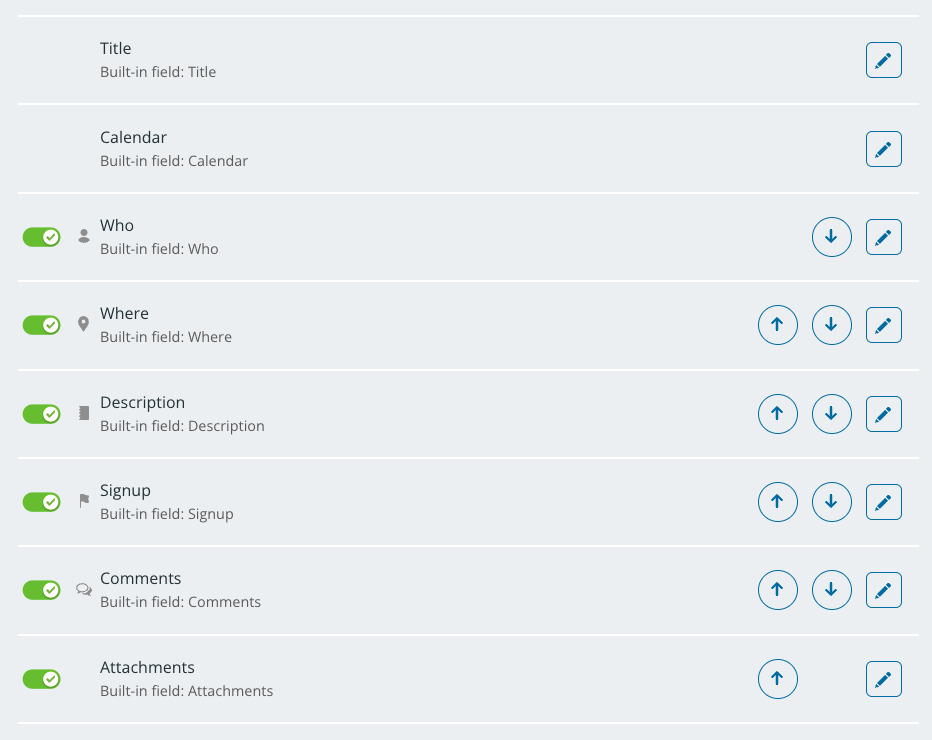Every Teamup Calendar has default event fields. These built-in event fields can be configured in certain ways such as renaming, rearranging, setting visibility, and setting certain defaults. Any custom event fields added to your calendar also have configuration options.
Default event fields

Every Teamup calendar has certain default event fields:
- Title
- Calendar
- Who
- Where
- Description
- Signup
- Comments
- Attachments
Default event fields vs custom event fields
Default event fields come built-in on every Teamup calendar. You also have the option to create custom event fields. There are different custom field types:
- text entry field type.
- choice field type with options (single choice or multiple choice).
- numerical data field type.
The number of custom fields you can add depends on your subscription plan. When you add a custom field, it appears in the same list with the built-in fields.
How to configure event fields
The calendar administrator can configure built-in event fields and custom event fields:
- Open the calendar in a browser.
- Go to Settings > Event Fields.
- You’ll see a screen with the list of event fields (as shown above).
- Click the Edit icon to the right of any event field to open the editor for that field to rename it, set the visibility, or manage other field options.
- Use the arrows to the right of any field to rearrange it.
- Use the toggle button to the left of an event field to deactivate (red, X mark) or activate (green, √ mark) it.
Configuring custom fields
You can configure a custom field when you create it. Custom fields will also be listed on the same screen with the built-in event fields: Settings > Event Fields. Click the pencil icon beside a custom field to open the editor and adjust the configuration as needed.
You can rename, rearrange, deactivate, and make other configuration choices for custom fields just as you can for built-in event fields. In addition, some custom fields have certain configuration options specific to their field type.
Limits on configuring fields
The Title field and Calendar field do not have all configuration options: they cannot be deactivated or rearranged.
The Signup and Comments field cannot be renamed.
Rename a field
To rename a field:
- Click the pencil icon beside an event field.
- On the next screen, put your cursor in the Name field and type in the name you want.

- Click the green Save button.
Rearrange event fields
Use the arrows to move a field up or down in the field order:
The event editor will reflect the changed field order immediately.
Deactivate or activate event fields
Use the toggle next to any event field to deactivate or activate it. When deactivated, the field will no longer be available on the event editor.
Make a field required
Check Yes in the Required section. Users will not be able to create or save edits on an event unless the required field is completed.
Show a field in the event title
Make a field show in the event title: The contents of the field will be shown in the event title, in parentheses.
Set visibility level
Scroll to the Visibility section. Select the option you want from the menu, then Save.
There are two visibility levels: All users or Users with modify permission.
- If the visibility control is All users, the event field will be visible to everyone who views the calendar, at any access level.
- If the visibility control is set to Users with modify permission, the event field will only be visible to users with modify-level access.
Configurable visibility for individual fields
The visibility setting applies to the individual field.
- You can have multiple fields of a certain type, e.g. custom choice fields.
- The visibility is set for each field individually.
So it’s possible to have multiple fields of the same type, with different visibility settings for each one.
Users with mixed permission levels
If a user has modify permission to one sub-calendar and read-only permission to another sub-calendar, the visibility setting will default to the lowest (e.g. read-only) level.
For example:
- A formatted text field is set to be visible only to Users with modify permission.
- An event is created and assigned to both Calendar A and Calendar B.
- User Bob has modify permission to Calendar A and read-only permission to Calendar B.
- When Bob view the event assigned to both Calendar A and Calendar B, he has the read-only permission to the event, therefore he will NOT be able to see the text field. In cases of mixed permission levels, a user’s lowest permission level is used to determine the field’s visibility for that user.
Set defaults for the Signup field
For the Signups field, you can set these defaults:
- Enabled: If checked, signups will be enabled on all newly created events by default.
- Deadline: Toggle on or off; set the default deadline for signups.
- Maximum number: Toggle on or off; set the default maximum number for signups.
- Who can view signups? Choose whether All users or Users with modify permission can see the list of users that signed up.
You can override these default settings on any individual event.
Set defaults for the Comments field
For the Comments field, you can set these defaults:
- Enabled: If checked, comments will be enabled on all newly created events by default.
- Who can view comments? Make comments available to All users or Users with modify permissions by default.
You can override these default settings on any individual event.







